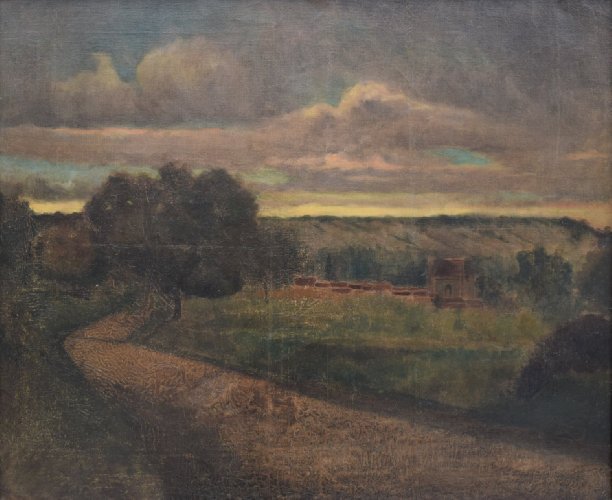Description:
Eugène Albert Moullé (1861-1940) – a French landscape painter born in Paris, possibly from the family of the famous piano maker Eugène Eduard Moullé. He was a student of Alfred Roll and the “Académie de La Palette” of Ferdinand Humbert and Henri Gervex. From 1890 he participated in the Salon of the Société des Artistes Français, and later in the Salon of the Société Nationale des Beaux-Arts, where he exhibited almost every year until World War II. In 1891 he became a member of the first of these associations, and in 1903 of the second, sitting several times in its jury (1904, 1908, 1924). In the first decades of the twentieth century he took part in several international exhibitions: Paris (1900), Saint-Louis (1904), Munich (1905), Rome (1911), Ghent (1913). In June 1914 he was awarded the title of knight of the Legion of Honor. He died on 23 February 1940 at his home in Moret-sur-Loing.
Description of painting:
This dark landscape depicts a road connecting two small, picturesque villages on the Loing River, located southeast of Paris and Fontainebleau in the departments of Seine-et-Marne in the Île de France region. At the turn of the 19th and 20th centuries, they were the homes of many artists who appreciated the charms of the local, familiar landscapes and the specific light. Among their favorite motifs were the old buildings of Montigny and Moret emphasized by the ribbon of the river and its overgrown banks. Examples are two recently discussed paintings by Albert Gosselin from the Rogalińska Gallery: “Evening on the Banks of Loing” and “Montigny sur Loing”. Moullé’s titular road is also seen in the evening light, further muted by the heavy canopy of clouds hanging over the horizontally outlined, bare hill closing the horizon. This is probably part of the Loing River Valley, which flows into the Seine after Moret. The road running diagonally from the bottom of the canvas and turning off at a certain distance leads us downhill, perhaps to the first buildings of Moret. Located in the middle of the canvas, to the right of the road, they are barely legible in their brown-earthy dress among the olive and steel green of the nearby meadow, trees and shrubs. Nevertheless, they harmonize with the road illuminated by a strip of fading, warm twilight visible over the distant hill. It brings out the last glimmers of gray blue of the sky among the heavy pink-beige clouds, whose glow nuances and unites in the pre-evening silence this seemingly uninteresting, but so tastefully colored, fading into twilight landscape.


